In-depth Report on Contemporary Issues in Business Analysis
VerifiedAdded on 2023/06/08
|17
|3644
|108
Report
AI Summary
This report examines contemporary issues in business analysis, focusing on the six knowledge areas prescribed by BABOK. It addresses business analysis planning and monitoring, including stakeholder engagement and activity planning. The report also covers elicitation and collaboration, emphasizing information acquisition from stakeholders. Requirement lifecycle management is discussed, highlighting requirement tracing and prioritization. Strategy analysis involves analyzing the current state, defining targeted needs, and assessing potential risks. Requirement analysis and design definition focus on structuring project requirements and identifying solutions. Finally, solution evaluation is explored to ensure alignment with business needs. This document is available on Desklib, a platform offering a wide range of solved assignments and study tools for students.
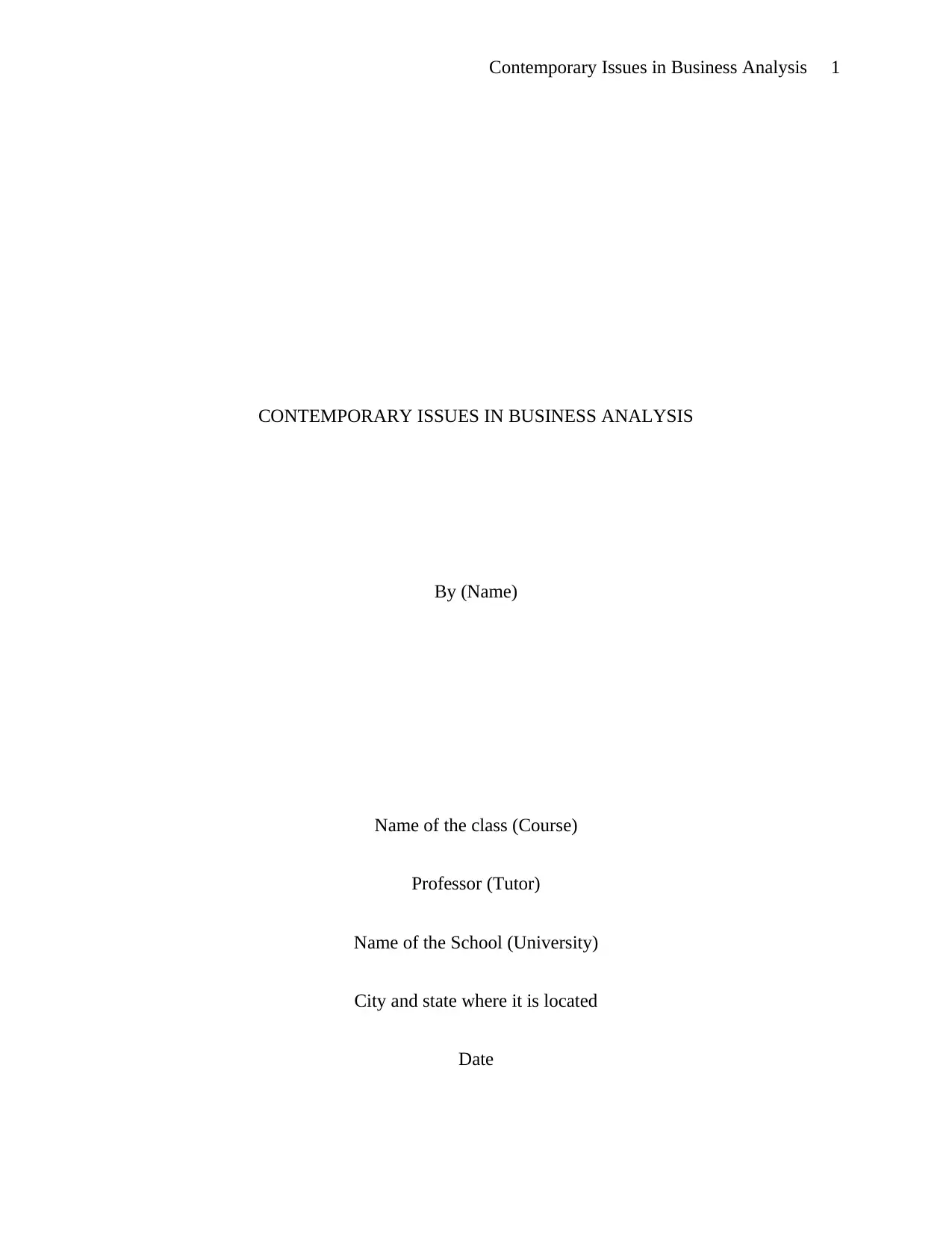
Contemporary Issues in Business Analysis 1
CONTEMPORARY ISSUES IN BUSINESS ANALYSIS
By (Name)
Name of the class (Course)
Professor (Tutor)
Name of the School (University)
City and state where it is located
Date
CONTEMPORARY ISSUES IN BUSINESS ANALYSIS
By (Name)
Name of the class (Course)
Professor (Tutor)
Name of the School (University)
City and state where it is located
Date
Paraphrase This Document
Need a fresh take? Get an instant paraphrase of this document with our AI Paraphraser
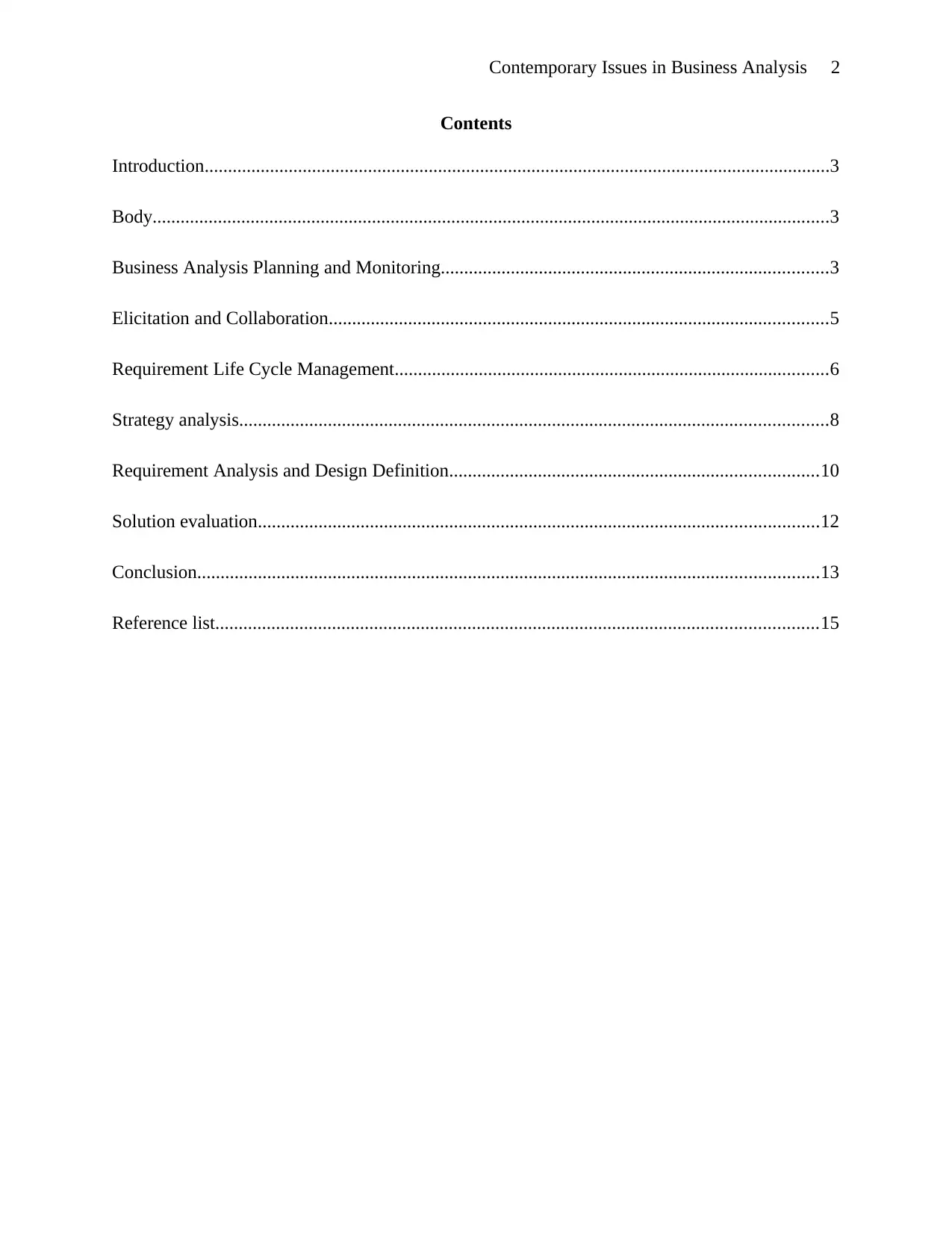
Contemporary Issues in Business Analysis 2
Contents
Introduction......................................................................................................................................3
Body.................................................................................................................................................3
Business Analysis Planning and Monitoring...................................................................................3
Elicitation and Collaboration...........................................................................................................5
Requirement Life Cycle Management.............................................................................................6
Strategy analysis..............................................................................................................................8
Requirement Analysis and Design Definition...............................................................................10
Solution evaluation........................................................................................................................12
Conclusion.....................................................................................................................................13
Reference list.................................................................................................................................15
Contents
Introduction......................................................................................................................................3
Body.................................................................................................................................................3
Business Analysis Planning and Monitoring...................................................................................3
Elicitation and Collaboration...........................................................................................................5
Requirement Life Cycle Management.............................................................................................6
Strategy analysis..............................................................................................................................8
Requirement Analysis and Design Definition...............................................................................10
Solution evaluation........................................................................................................................12
Conclusion.....................................................................................................................................13
Reference list.................................................................................................................................15
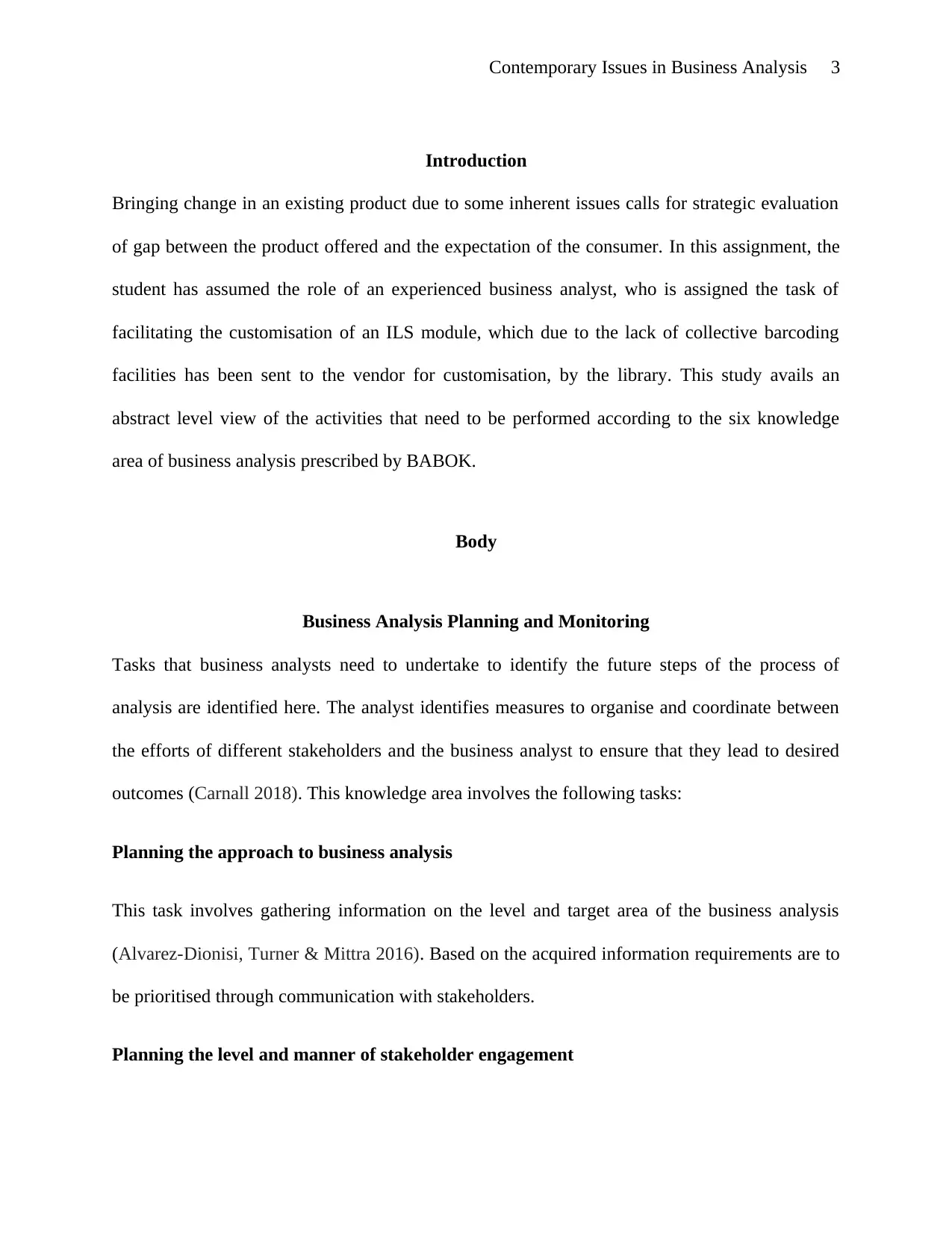
Contemporary Issues in Business Analysis 3
Introduction
Bringing change in an existing product due to some inherent issues calls for strategic evaluation
of gap between the product offered and the expectation of the consumer. In this assignment, the
student has assumed the role of an experienced business analyst, who is assigned the task of
facilitating the customisation of an ILS module, which due to the lack of collective barcoding
facilities has been sent to the vendor for customisation, by the library. This study avails an
abstract level view of the activities that need to be performed according to the six knowledge
area of business analysis prescribed by BABOK.
Body
Business Analysis Planning and Monitoring
Tasks that business analysts need to undertake to identify the future steps of the process of
analysis are identified here. The analyst identifies measures to organise and coordinate between
the efforts of different stakeholders and the business analyst to ensure that they lead to desired
outcomes (Carnall 2018). This knowledge area involves the following tasks:
Planning the approach to business analysis
This task involves gathering information on the level and target area of the business analysis
(Alvarez-Dionisi, Turner & Mittra 2016). Based on the acquired information requirements are to
be prioritised through communication with stakeholders.
Planning the level and manner of stakeholder engagement
Introduction
Bringing change in an existing product due to some inherent issues calls for strategic evaluation
of gap between the product offered and the expectation of the consumer. In this assignment, the
student has assumed the role of an experienced business analyst, who is assigned the task of
facilitating the customisation of an ILS module, which due to the lack of collective barcoding
facilities has been sent to the vendor for customisation, by the library. This study avails an
abstract level view of the activities that need to be performed according to the six knowledge
area of business analysis prescribed by BABOK.
Body
Business Analysis Planning and Monitoring
Tasks that business analysts need to undertake to identify the future steps of the process of
analysis are identified here. The analyst identifies measures to organise and coordinate between
the efforts of different stakeholders and the business analyst to ensure that they lead to desired
outcomes (Carnall 2018). This knowledge area involves the following tasks:
Planning the approach to business analysis
This task involves gathering information on the level and target area of the business analysis
(Alvarez-Dionisi, Turner & Mittra 2016). Based on the acquired information requirements are to
be prioritised through communication with stakeholders.
Planning the level and manner of stakeholder engagement
⊘ This is a preview!⊘
Do you want full access?
Subscribe today to unlock all pages.

Trusted by 1+ million students worldwide
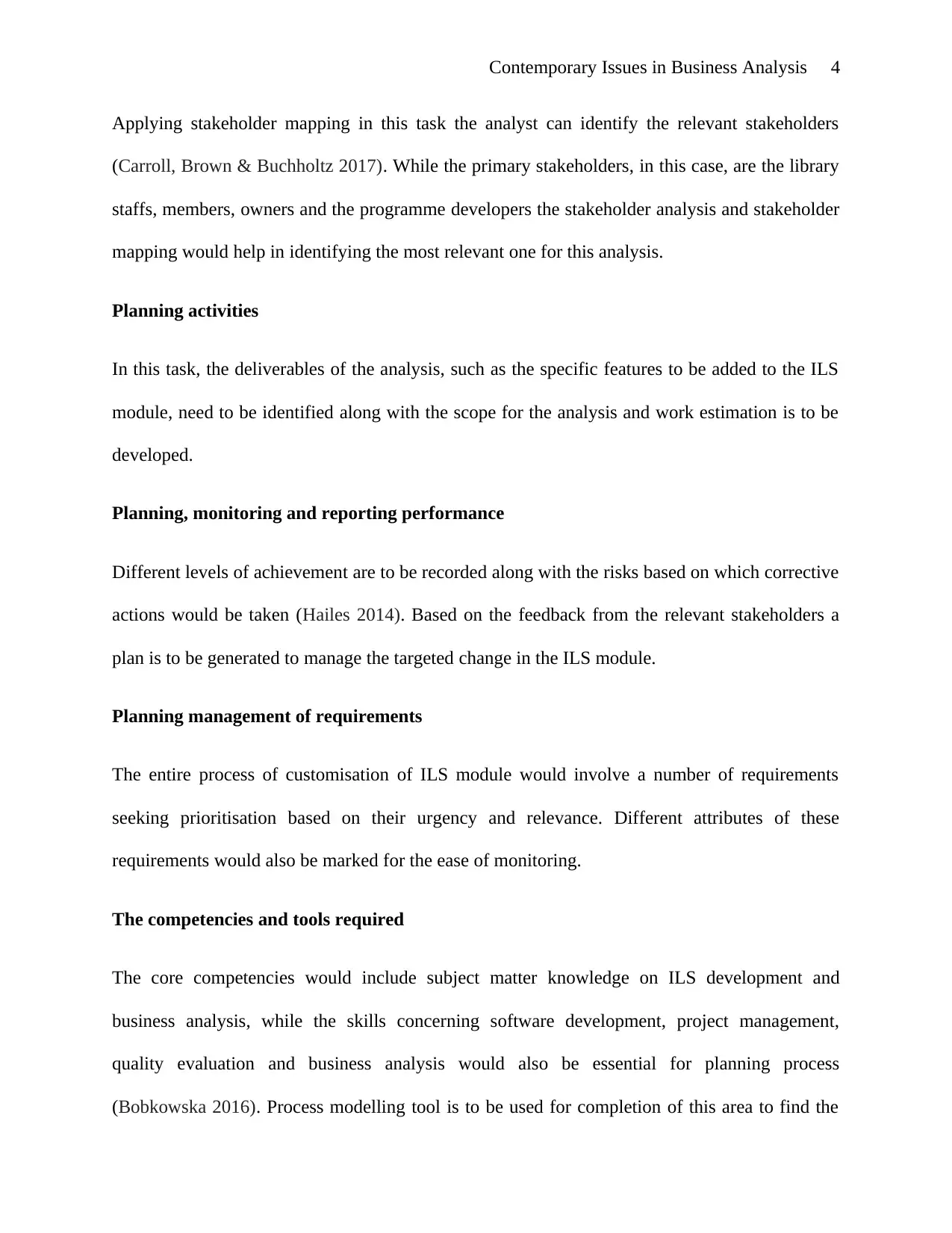
Contemporary Issues in Business Analysis 4
Applying stakeholder mapping in this task the analyst can identify the relevant stakeholders
(Carroll, Brown & Buchholtz 2017). While the primary stakeholders, in this case, are the library
staffs, members, owners and the programme developers the stakeholder analysis and stakeholder
mapping would help in identifying the most relevant one for this analysis.
Planning activities
In this task, the deliverables of the analysis, such as the specific features to be added to the ILS
module, need to be identified along with the scope for the analysis and work estimation is to be
developed.
Planning, monitoring and reporting performance
Different levels of achievement are to be recorded along with the risks based on which corrective
actions would be taken (Hailes 2014). Based on the feedback from the relevant stakeholders a
plan is to be generated to manage the targeted change in the ILS module.
Planning management of requirements
The entire process of customisation of ILS module would involve a number of requirements
seeking prioritisation based on their urgency and relevance. Different attributes of these
requirements would also be marked for the ease of monitoring.
The competencies and tools required
The core competencies would include subject matter knowledge on ILS development and
business analysis, while the skills concerning software development, project management,
quality evaluation and business analysis would also be essential for planning process
(Bobkowska 2016). Process modelling tool is to be used for completion of this area to find the
Applying stakeholder mapping in this task the analyst can identify the relevant stakeholders
(Carroll, Brown & Buchholtz 2017). While the primary stakeholders, in this case, are the library
staffs, members, owners and the programme developers the stakeholder analysis and stakeholder
mapping would help in identifying the most relevant one for this analysis.
Planning activities
In this task, the deliverables of the analysis, such as the specific features to be added to the ILS
module, need to be identified along with the scope for the analysis and work estimation is to be
developed.
Planning, monitoring and reporting performance
Different levels of achievement are to be recorded along with the risks based on which corrective
actions would be taken (Hailes 2014). Based on the feedback from the relevant stakeholders a
plan is to be generated to manage the targeted change in the ILS module.
Planning management of requirements
The entire process of customisation of ILS module would involve a number of requirements
seeking prioritisation based on their urgency and relevance. Different attributes of these
requirements would also be marked for the ease of monitoring.
The competencies and tools required
The core competencies would include subject matter knowledge on ILS development and
business analysis, while the skills concerning software development, project management,
quality evaluation and business analysis would also be essential for planning process
(Bobkowska 2016). Process modelling tool is to be used for completion of this area to find the
Paraphrase This Document
Need a fresh take? Get an instant paraphrase of this document with our AI Paraphraser
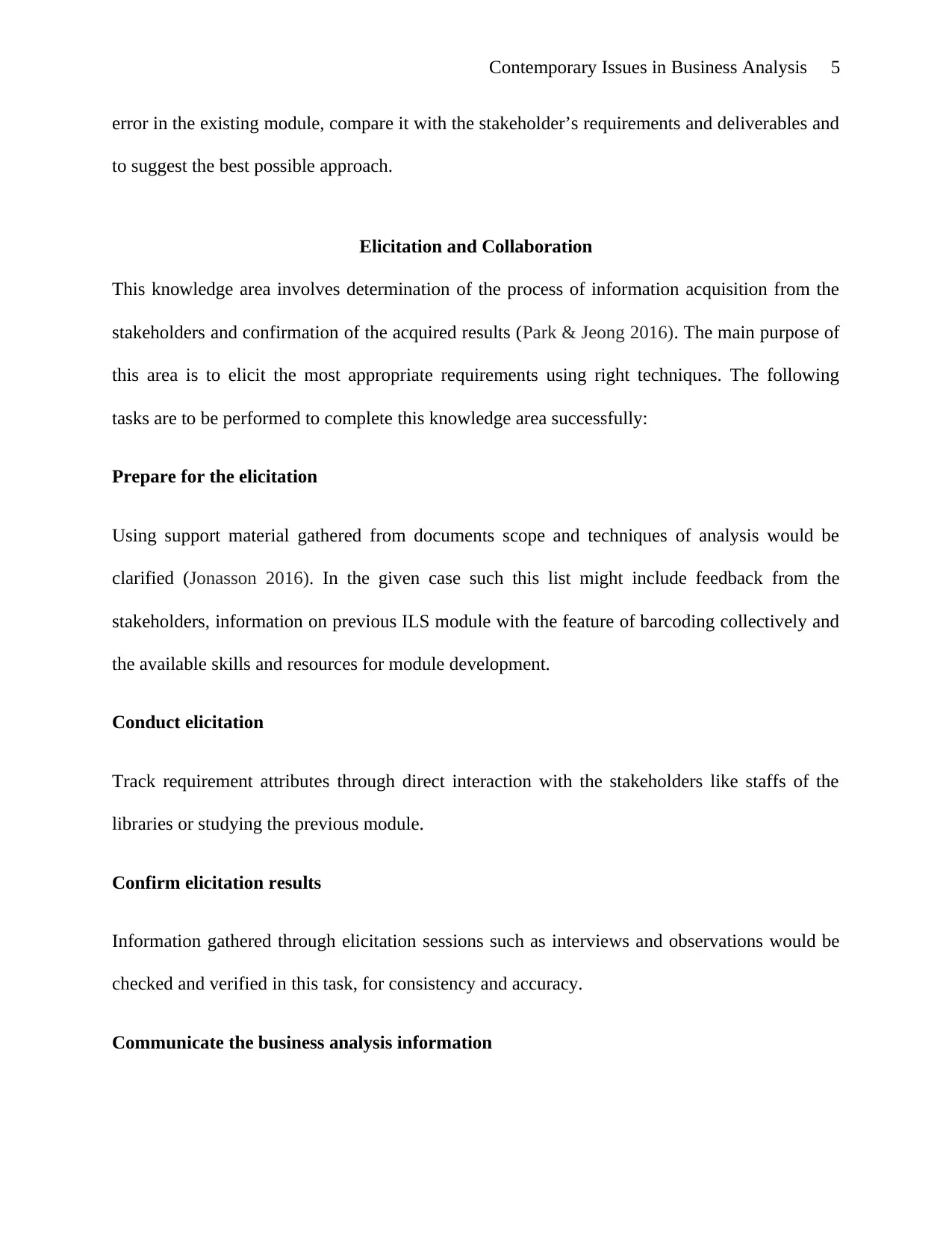
Contemporary Issues in Business Analysis 5
error in the existing module, compare it with the stakeholder’s requirements and deliverables and
to suggest the best possible approach.
Elicitation and Collaboration
This knowledge area involves determination of the process of information acquisition from the
stakeholders and confirmation of the acquired results (Park & Jeong 2016). The main purpose of
this area is to elicit the most appropriate requirements using right techniques. The following
tasks are to be performed to complete this knowledge area successfully:
Prepare for the elicitation
Using support material gathered from documents scope and techniques of analysis would be
clarified (Jonasson 2016). In the given case such this list might include feedback from the
stakeholders, information on previous ILS module with the feature of barcoding collectively and
the available skills and resources for module development.
Conduct elicitation
Track requirement attributes through direct interaction with the stakeholders like staffs of the
libraries or studying the previous module.
Confirm elicitation results
Information gathered through elicitation sessions such as interviews and observations would be
checked and verified in this task, for consistency and accuracy.
Communicate the business analysis information
error in the existing module, compare it with the stakeholder’s requirements and deliverables and
to suggest the best possible approach.
Elicitation and Collaboration
This knowledge area involves determination of the process of information acquisition from the
stakeholders and confirmation of the acquired results (Park & Jeong 2016). The main purpose of
this area is to elicit the most appropriate requirements using right techniques. The following
tasks are to be performed to complete this knowledge area successfully:
Prepare for the elicitation
Using support material gathered from documents scope and techniques of analysis would be
clarified (Jonasson 2016). In the given case such this list might include feedback from the
stakeholders, information on previous ILS module with the feature of barcoding collectively and
the available skills and resources for module development.
Conduct elicitation
Track requirement attributes through direct interaction with the stakeholders like staffs of the
libraries or studying the previous module.
Confirm elicitation results
Information gathered through elicitation sessions such as interviews and observations would be
checked and verified in this task, for consistency and accuracy.
Communicate the business analysis information
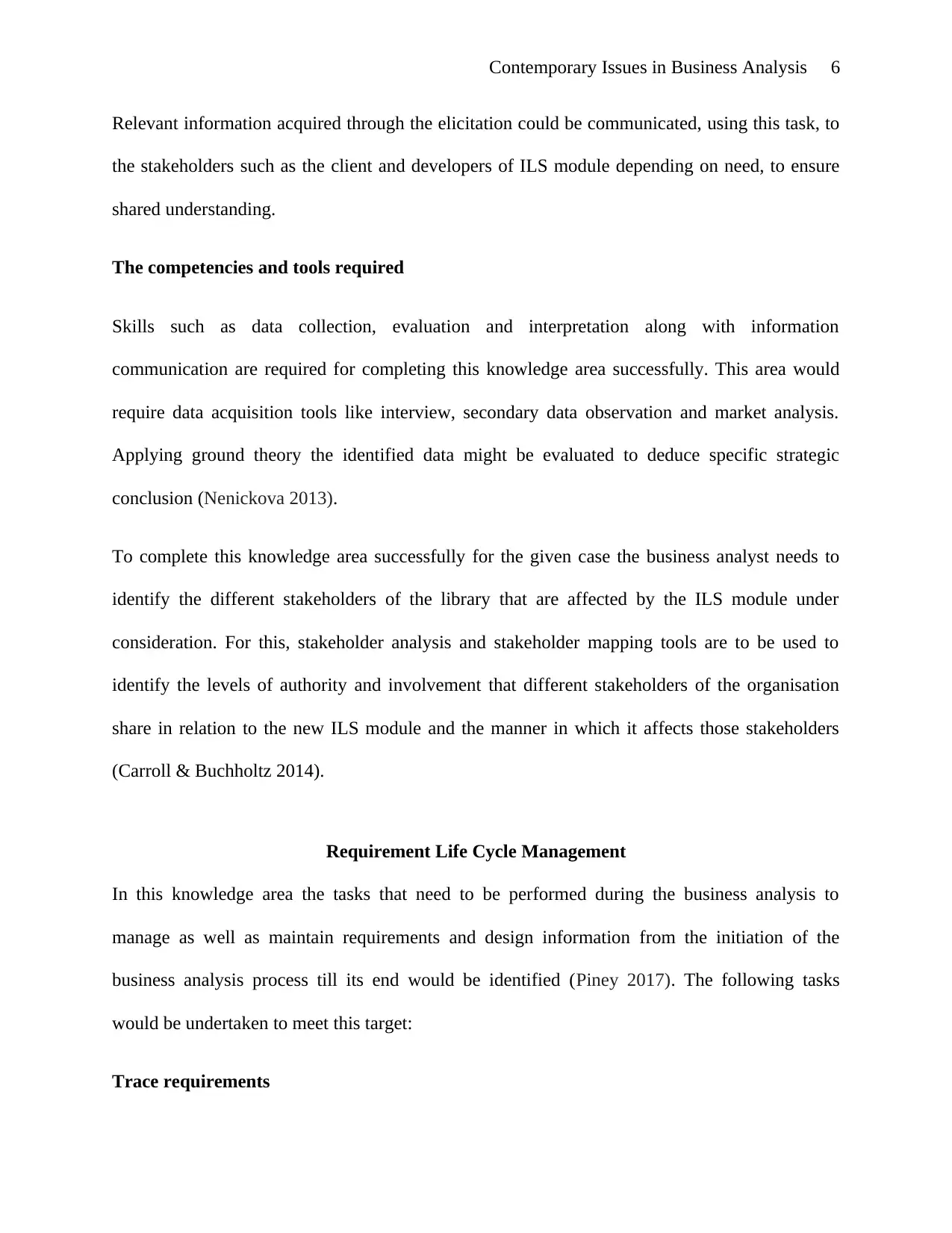
Contemporary Issues in Business Analysis 6
Relevant information acquired through the elicitation could be communicated, using this task, to
the stakeholders such as the client and developers of ILS module depending on need, to ensure
shared understanding.
The competencies and tools required
Skills such as data collection, evaluation and interpretation along with information
communication are required for completing this knowledge area successfully. This area would
require data acquisition tools like interview, secondary data observation and market analysis.
Applying ground theory the identified data might be evaluated to deduce specific strategic
conclusion (Nenickova 2013).
To complete this knowledge area successfully for the given case the business analyst needs to
identify the different stakeholders of the library that are affected by the ILS module under
consideration. For this, stakeholder analysis and stakeholder mapping tools are to be used to
identify the levels of authority and involvement that different stakeholders of the organisation
share in relation to the new ILS module and the manner in which it affects those stakeholders
(Carroll & Buchholtz 2014).
Requirement Life Cycle Management
In this knowledge area the tasks that need to be performed during the business analysis to
manage as well as maintain requirements and design information from the initiation of the
business analysis process till its end would be identified (Piney 2017). The following tasks
would be undertaken to meet this target:
Trace requirements
Relevant information acquired through the elicitation could be communicated, using this task, to
the stakeholders such as the client and developers of ILS module depending on need, to ensure
shared understanding.
The competencies and tools required
Skills such as data collection, evaluation and interpretation along with information
communication are required for completing this knowledge area successfully. This area would
require data acquisition tools like interview, secondary data observation and market analysis.
Applying ground theory the identified data might be evaluated to deduce specific strategic
conclusion (Nenickova 2013).
To complete this knowledge area successfully for the given case the business analyst needs to
identify the different stakeholders of the library that are affected by the ILS module under
consideration. For this, stakeholder analysis and stakeholder mapping tools are to be used to
identify the levels of authority and involvement that different stakeholders of the organisation
share in relation to the new ILS module and the manner in which it affects those stakeholders
(Carroll & Buchholtz 2014).
Requirement Life Cycle Management
In this knowledge area the tasks that need to be performed during the business analysis to
manage as well as maintain requirements and design information from the initiation of the
business analysis process till its end would be identified (Piney 2017). The following tasks
would be undertaken to meet this target:
Trace requirements
⊘ This is a preview!⊘
Do you want full access?
Subscribe today to unlock all pages.

Trusted by 1+ million students worldwide
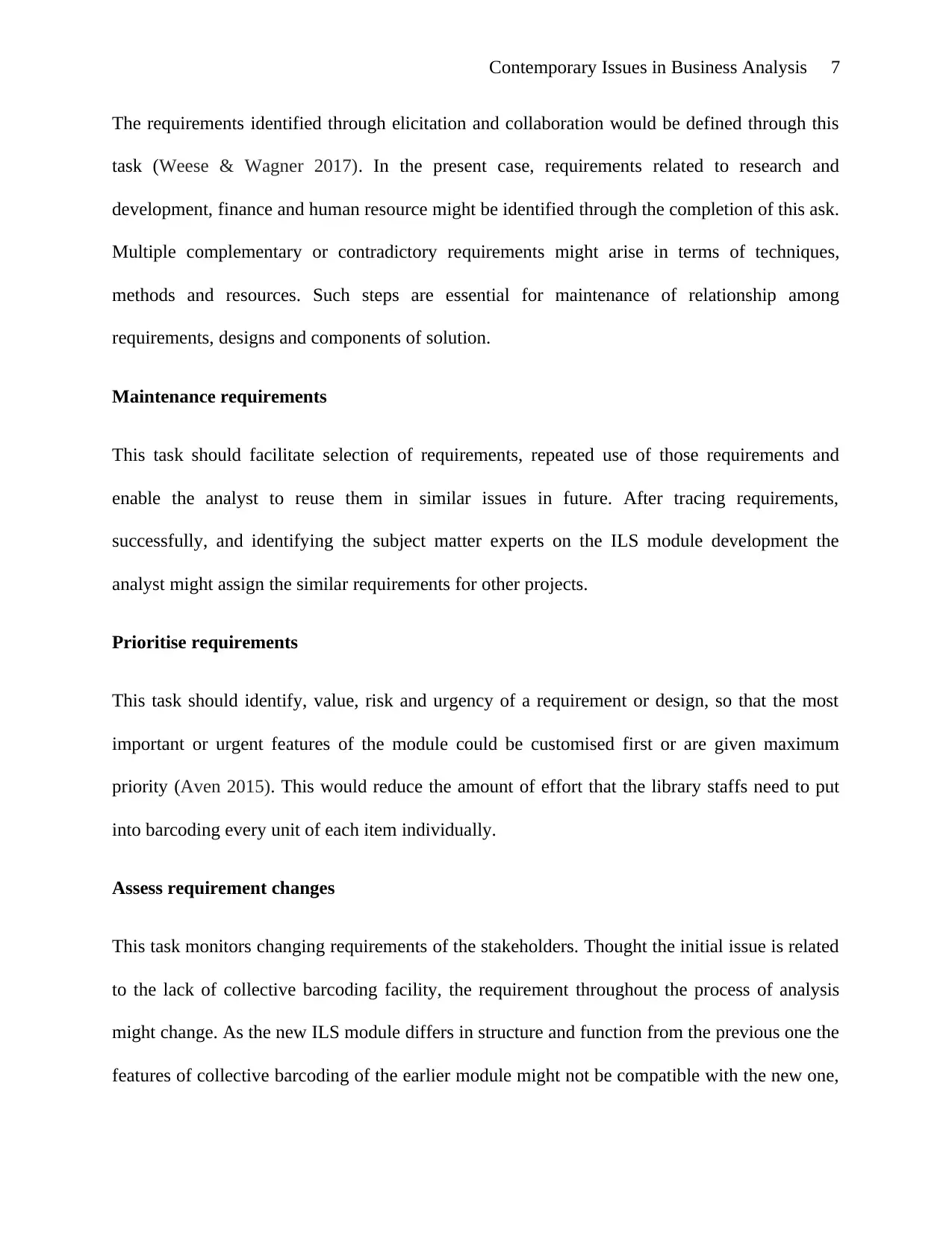
Contemporary Issues in Business Analysis 7
The requirements identified through elicitation and collaboration would be defined through this
task (Weese & Wagner 2017). In the present case, requirements related to research and
development, finance and human resource might be identified through the completion of this ask.
Multiple complementary or contradictory requirements might arise in terms of techniques,
methods and resources. Such steps are essential for maintenance of relationship among
requirements, designs and components of solution.
Maintenance requirements
This task should facilitate selection of requirements, repeated use of those requirements and
enable the analyst to reuse them in similar issues in future. After tracing requirements,
successfully, and identifying the subject matter experts on the ILS module development the
analyst might assign the similar requirements for other projects.
Prioritise requirements
This task should identify, value, risk and urgency of a requirement or design, so that the most
important or urgent features of the module could be customised first or are given maximum
priority (Aven 2015). This would reduce the amount of effort that the library staffs need to put
into barcoding every unit of each item individually.
Assess requirement changes
This task monitors changing requirements of the stakeholders. Thought the initial issue is related
to the lack of collective barcoding facility, the requirement throughout the process of analysis
might change. As the new ILS module differs in structure and function from the previous one the
features of collective barcoding of the earlier module might not be compatible with the new one,
The requirements identified through elicitation and collaboration would be defined through this
task (Weese & Wagner 2017). In the present case, requirements related to research and
development, finance and human resource might be identified through the completion of this ask.
Multiple complementary or contradictory requirements might arise in terms of techniques,
methods and resources. Such steps are essential for maintenance of relationship among
requirements, designs and components of solution.
Maintenance requirements
This task should facilitate selection of requirements, repeated use of those requirements and
enable the analyst to reuse them in similar issues in future. After tracing requirements,
successfully, and identifying the subject matter experts on the ILS module development the
analyst might assign the similar requirements for other projects.
Prioritise requirements
This task should identify, value, risk and urgency of a requirement or design, so that the most
important or urgent features of the module could be customised first or are given maximum
priority (Aven 2015). This would reduce the amount of effort that the library staffs need to put
into barcoding every unit of each item individually.
Assess requirement changes
This task monitors changing requirements of the stakeholders. Thought the initial issue is related
to the lack of collective barcoding facility, the requirement throughout the process of analysis
might change. As the new ILS module differs in structure and function from the previous one the
features of collective barcoding of the earlier module might not be compatible with the new one,
Paraphrase This Document
Need a fresh take? Get an instant paraphrase of this document with our AI Paraphraser
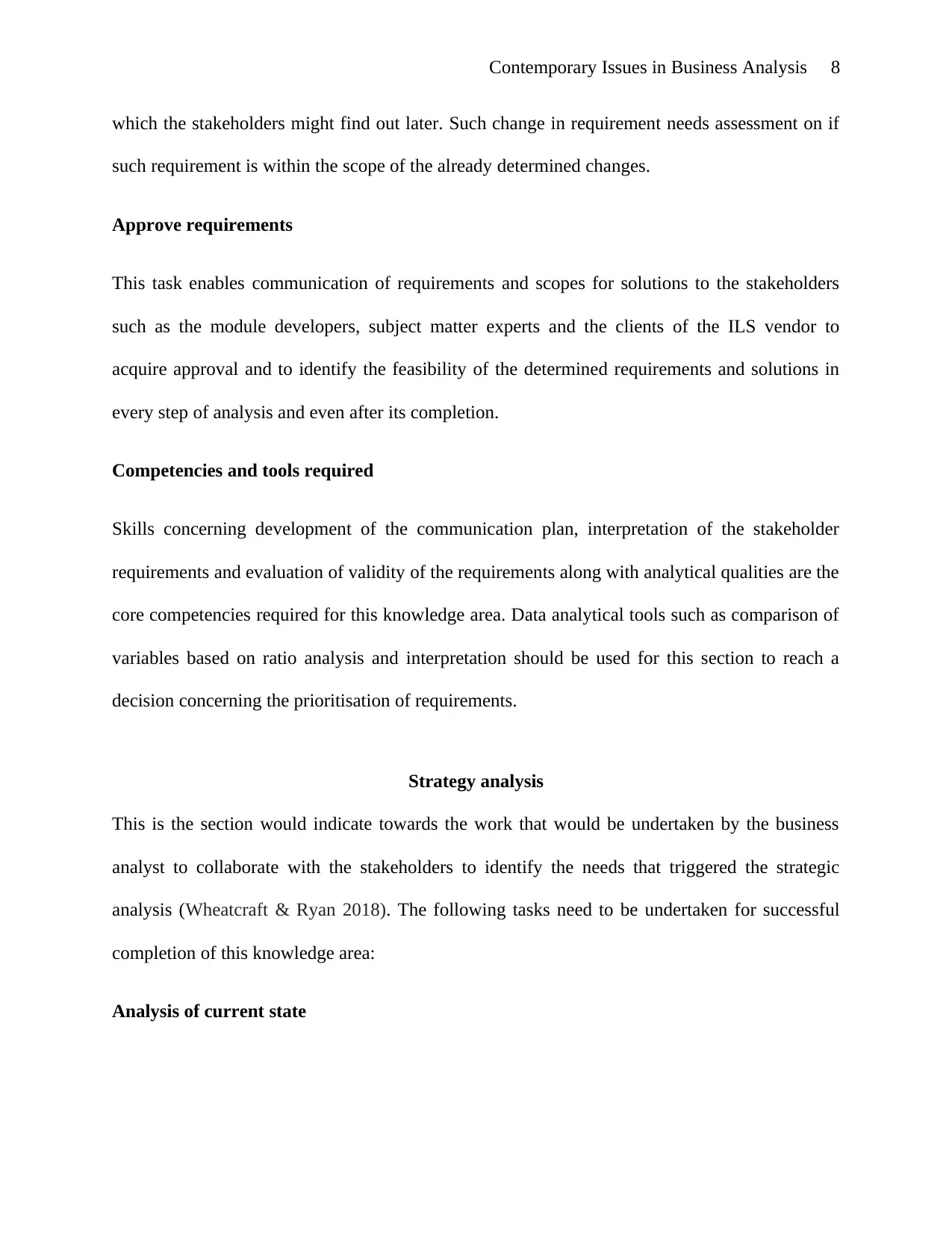
Contemporary Issues in Business Analysis 8
which the stakeholders might find out later. Such change in requirement needs assessment on if
such requirement is within the scope of the already determined changes.
Approve requirements
This task enables communication of requirements and scopes for solutions to the stakeholders
such as the module developers, subject matter experts and the clients of the ILS vendor to
acquire approval and to identify the feasibility of the determined requirements and solutions in
every step of analysis and even after its completion.
Competencies and tools required
Skills concerning development of the communication plan, interpretation of the stakeholder
requirements and evaluation of validity of the requirements along with analytical qualities are the
core competencies required for this knowledge area. Data analytical tools such as comparison of
variables based on ratio analysis and interpretation should be used for this section to reach a
decision concerning the prioritisation of requirements.
Strategy analysis
This is the section would indicate towards the work that would be undertaken by the business
analyst to collaborate with the stakeholders to identify the needs that triggered the strategic
analysis (Wheatcraft & Ryan 2018). The following tasks need to be undertaken for successful
completion of this knowledge area:
Analysis of current state
which the stakeholders might find out later. Such change in requirement needs assessment on if
such requirement is within the scope of the already determined changes.
Approve requirements
This task enables communication of requirements and scopes for solutions to the stakeholders
such as the module developers, subject matter experts and the clients of the ILS vendor to
acquire approval and to identify the feasibility of the determined requirements and solutions in
every step of analysis and even after its completion.
Competencies and tools required
Skills concerning development of the communication plan, interpretation of the stakeholder
requirements and evaluation of validity of the requirements along with analytical qualities are the
core competencies required for this knowledge area. Data analytical tools such as comparison of
variables based on ratio analysis and interpretation should be used for this section to reach a
decision concerning the prioritisation of requirements.
Strategy analysis
This is the section would indicate towards the work that would be undertaken by the business
analyst to collaborate with the stakeholders to identify the needs that triggered the strategic
analysis (Wheatcraft & Ryan 2018). The following tasks need to be undertaken for successful
completion of this knowledge area:
Analysis of current state
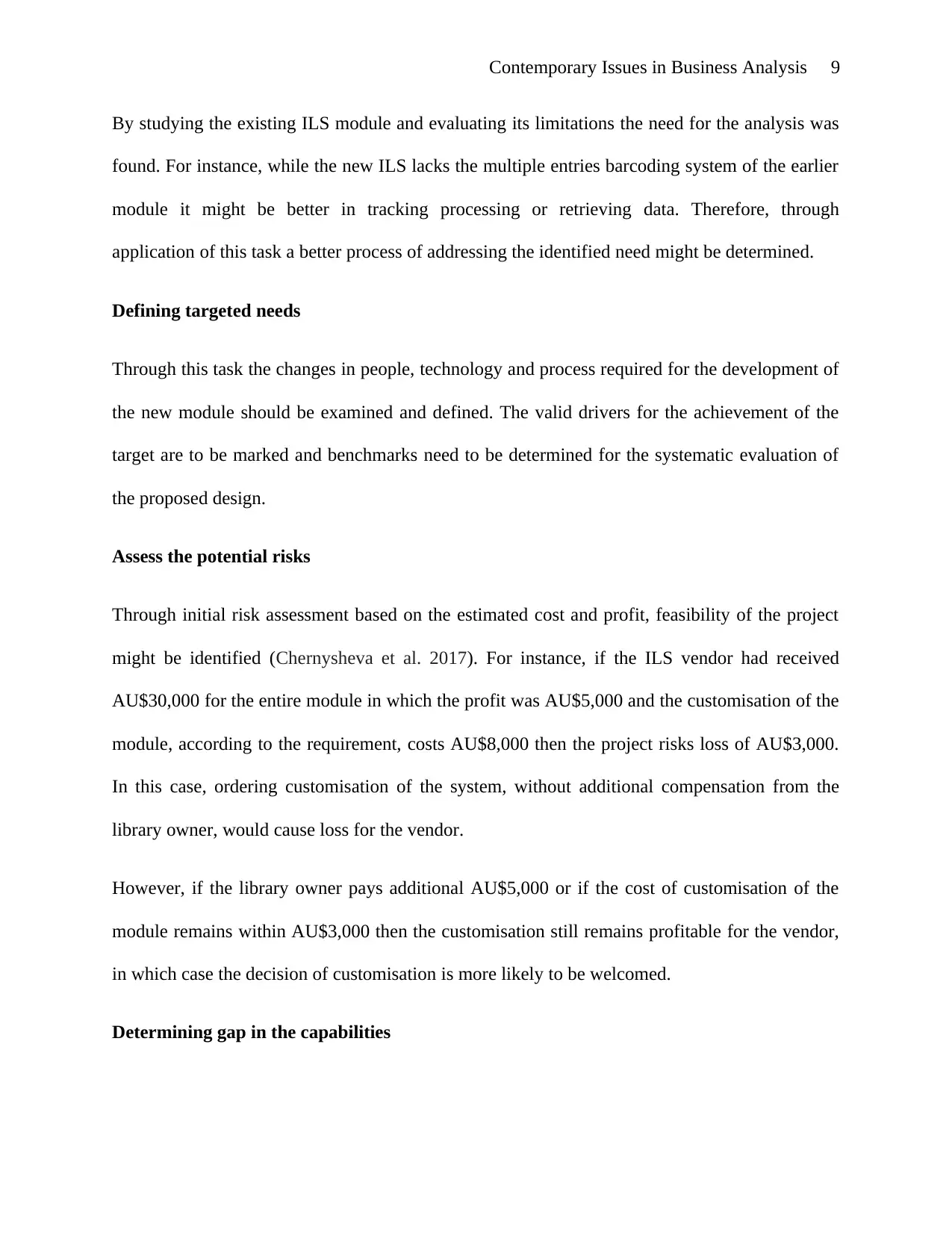
Contemporary Issues in Business Analysis 9
By studying the existing ILS module and evaluating its limitations the need for the analysis was
found. For instance, while the new ILS lacks the multiple entries barcoding system of the earlier
module it might be better in tracking processing or retrieving data. Therefore, through
application of this task a better process of addressing the identified need might be determined.
Defining targeted needs
Through this task the changes in people, technology and process required for the development of
the new module should be examined and defined. The valid drivers for the achievement of the
target are to be marked and benchmarks need to be determined for the systematic evaluation of
the proposed design.
Assess the potential risks
Through initial risk assessment based on the estimated cost and profit, feasibility of the project
might be identified (Chernysheva et al. 2017). For instance, if the ILS vendor had received
AU$30,000 for the entire module in which the profit was AU$5,000 and the customisation of the
module, according to the requirement, costs AU$8,000 then the project risks loss of AU$3,000.
In this case, ordering customisation of the system, without additional compensation from the
library owner, would cause loss for the vendor.
However, if the library owner pays additional AU$5,000 or if the cost of customisation of the
module remains within AU$3,000 then the customisation still remains profitable for the vendor,
in which case the decision of customisation is more likely to be welcomed.
Determining gap in the capabilities
By studying the existing ILS module and evaluating its limitations the need for the analysis was
found. For instance, while the new ILS lacks the multiple entries barcoding system of the earlier
module it might be better in tracking processing or retrieving data. Therefore, through
application of this task a better process of addressing the identified need might be determined.
Defining targeted needs
Through this task the changes in people, technology and process required for the development of
the new module should be examined and defined. The valid drivers for the achievement of the
target are to be marked and benchmarks need to be determined for the systematic evaluation of
the proposed design.
Assess the potential risks
Through initial risk assessment based on the estimated cost and profit, feasibility of the project
might be identified (Chernysheva et al. 2017). For instance, if the ILS vendor had received
AU$30,000 for the entire module in which the profit was AU$5,000 and the customisation of the
module, according to the requirement, costs AU$8,000 then the project risks loss of AU$3,000.
In this case, ordering customisation of the system, without additional compensation from the
library owner, would cause loss for the vendor.
However, if the library owner pays additional AU$5,000 or if the cost of customisation of the
module remains within AU$3,000 then the customisation still remains profitable for the vendor,
in which case the decision of customisation is more likely to be welcomed.
Determining gap in the capabilities
⊘ This is a preview!⊘
Do you want full access?
Subscribe today to unlock all pages.

Trusted by 1+ million students worldwide
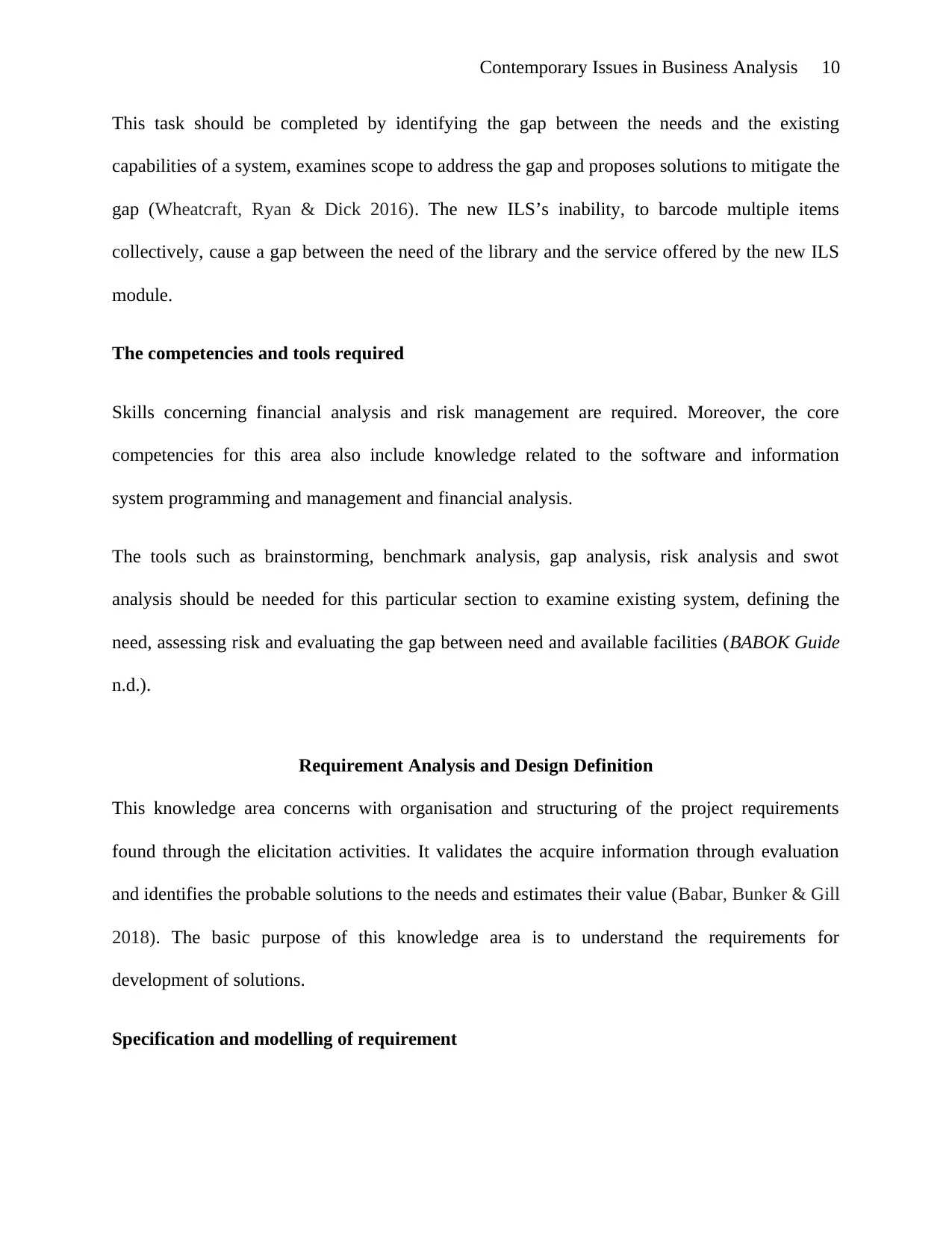
Contemporary Issues in Business Analysis 10
This task should be completed by identifying the gap between the needs and the existing
capabilities of a system, examines scope to address the gap and proposes solutions to mitigate the
gap (Wheatcraft, Ryan & Dick 2016). The new ILS’s inability, to barcode multiple items
collectively, cause a gap between the need of the library and the service offered by the new ILS
module.
The competencies and tools required
Skills concerning financial analysis and risk management are required. Moreover, the core
competencies for this area also include knowledge related to the software and information
system programming and management and financial analysis.
The tools such as brainstorming, benchmark analysis, gap analysis, risk analysis and swot
analysis should be needed for this particular section to examine existing system, defining the
need, assessing risk and evaluating the gap between need and available facilities (BABOK Guide
n.d.).
Requirement Analysis and Design Definition
This knowledge area concerns with organisation and structuring of the project requirements
found through the elicitation activities. It validates the acquire information through evaluation
and identifies the probable solutions to the needs and estimates their value (Babar, Bunker & Gill
2018). The basic purpose of this knowledge area is to understand the requirements for
development of solutions.
Specification and modelling of requirement
This task should be completed by identifying the gap between the needs and the existing
capabilities of a system, examines scope to address the gap and proposes solutions to mitigate the
gap (Wheatcraft, Ryan & Dick 2016). The new ILS’s inability, to barcode multiple items
collectively, cause a gap between the need of the library and the service offered by the new ILS
module.
The competencies and tools required
Skills concerning financial analysis and risk management are required. Moreover, the core
competencies for this area also include knowledge related to the software and information
system programming and management and financial analysis.
The tools such as brainstorming, benchmark analysis, gap analysis, risk analysis and swot
analysis should be needed for this particular section to examine existing system, defining the
need, assessing risk and evaluating the gap between need and available facilities (BABOK Guide
n.d.).
Requirement Analysis and Design Definition
This knowledge area concerns with organisation and structuring of the project requirements
found through the elicitation activities. It validates the acquire information through evaluation
and identifies the probable solutions to the needs and estimates their value (Babar, Bunker & Gill
2018). The basic purpose of this knowledge area is to understand the requirements for
development of solutions.
Specification and modelling of requirement
Paraphrase This Document
Need a fresh take? Get an instant paraphrase of this document with our AI Paraphraser
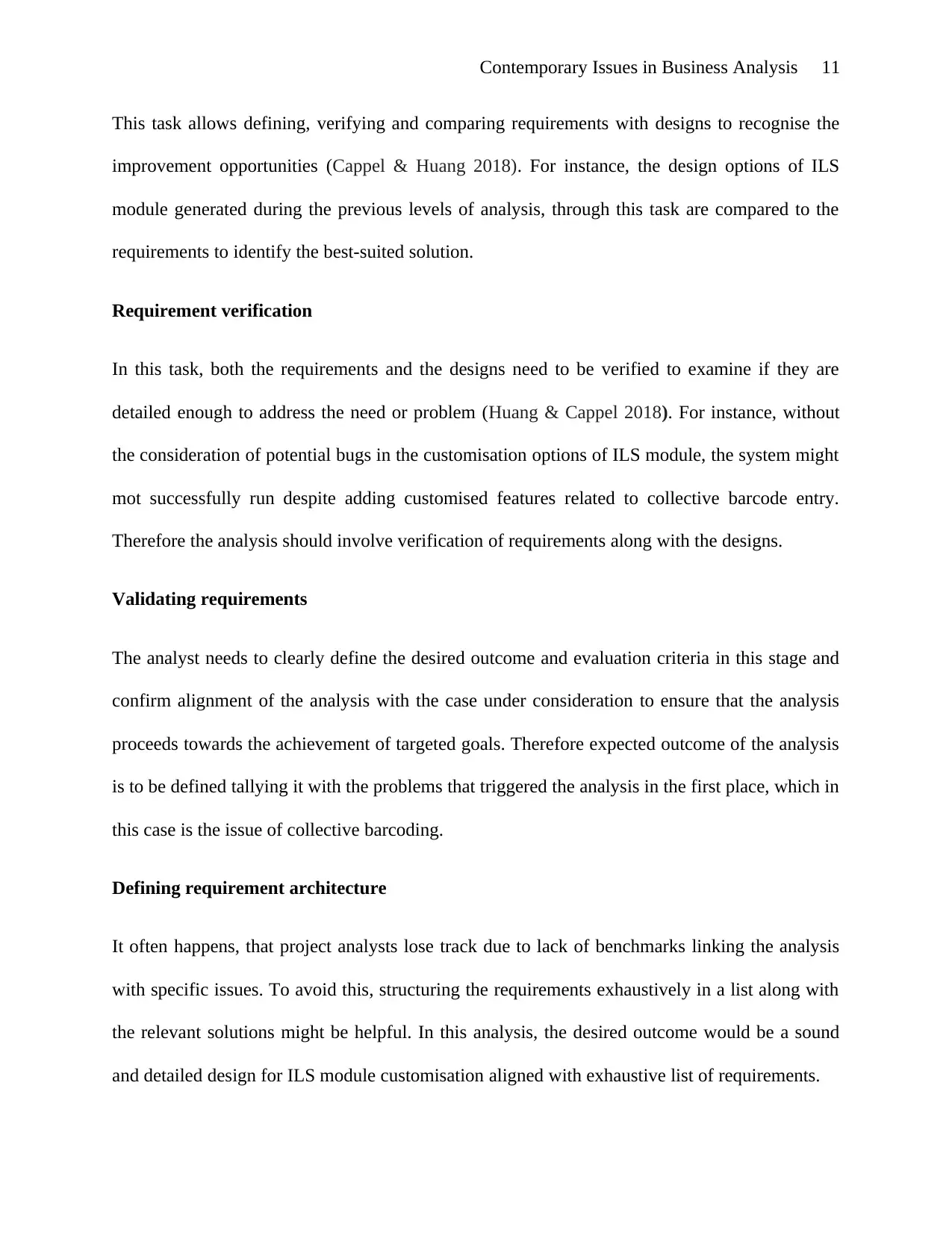
Contemporary Issues in Business Analysis 11
This task allows defining, verifying and comparing requirements with designs to recognise the
improvement opportunities (Cappel & Huang 2018). For instance, the design options of ILS
module generated during the previous levels of analysis, through this task are compared to the
requirements to identify the best-suited solution.
Requirement verification
In this task, both the requirements and the designs need to be verified to examine if they are
detailed enough to address the need or problem (Huang & Cappel 2018). For instance, without
the consideration of potential bugs in the customisation options of ILS module, the system might
mot successfully run despite adding customised features related to collective barcode entry.
Therefore the analysis should involve verification of requirements along with the designs.
Validating requirements
The analyst needs to clearly define the desired outcome and evaluation criteria in this stage and
confirm alignment of the analysis with the case under consideration to ensure that the analysis
proceeds towards the achievement of targeted goals. Therefore expected outcome of the analysis
is to be defined tallying it with the problems that triggered the analysis in the first place, which in
this case is the issue of collective barcoding.
Defining requirement architecture
It often happens, that project analysts lose track due to lack of benchmarks linking the analysis
with specific issues. To avoid this, structuring the requirements exhaustively in a list along with
the relevant solutions might be helpful. In this analysis, the desired outcome would be a sound
and detailed design for ILS module customisation aligned with exhaustive list of requirements.
This task allows defining, verifying and comparing requirements with designs to recognise the
improvement opportunities (Cappel & Huang 2018). For instance, the design options of ILS
module generated during the previous levels of analysis, through this task are compared to the
requirements to identify the best-suited solution.
Requirement verification
In this task, both the requirements and the designs need to be verified to examine if they are
detailed enough to address the need or problem (Huang & Cappel 2018). For instance, without
the consideration of potential bugs in the customisation options of ILS module, the system might
mot successfully run despite adding customised features related to collective barcode entry.
Therefore the analysis should involve verification of requirements along with the designs.
Validating requirements
The analyst needs to clearly define the desired outcome and evaluation criteria in this stage and
confirm alignment of the analysis with the case under consideration to ensure that the analysis
proceeds towards the achievement of targeted goals. Therefore expected outcome of the analysis
is to be defined tallying it with the problems that triggered the analysis in the first place, which in
this case is the issue of collective barcoding.
Defining requirement architecture
It often happens, that project analysts lose track due to lack of benchmarks linking the analysis
with specific issues. To avoid this, structuring the requirements exhaustively in a list along with
the relevant solutions might be helpful. In this analysis, the desired outcome would be a sound
and detailed design for ILS module customisation aligned with exhaustive list of requirements.
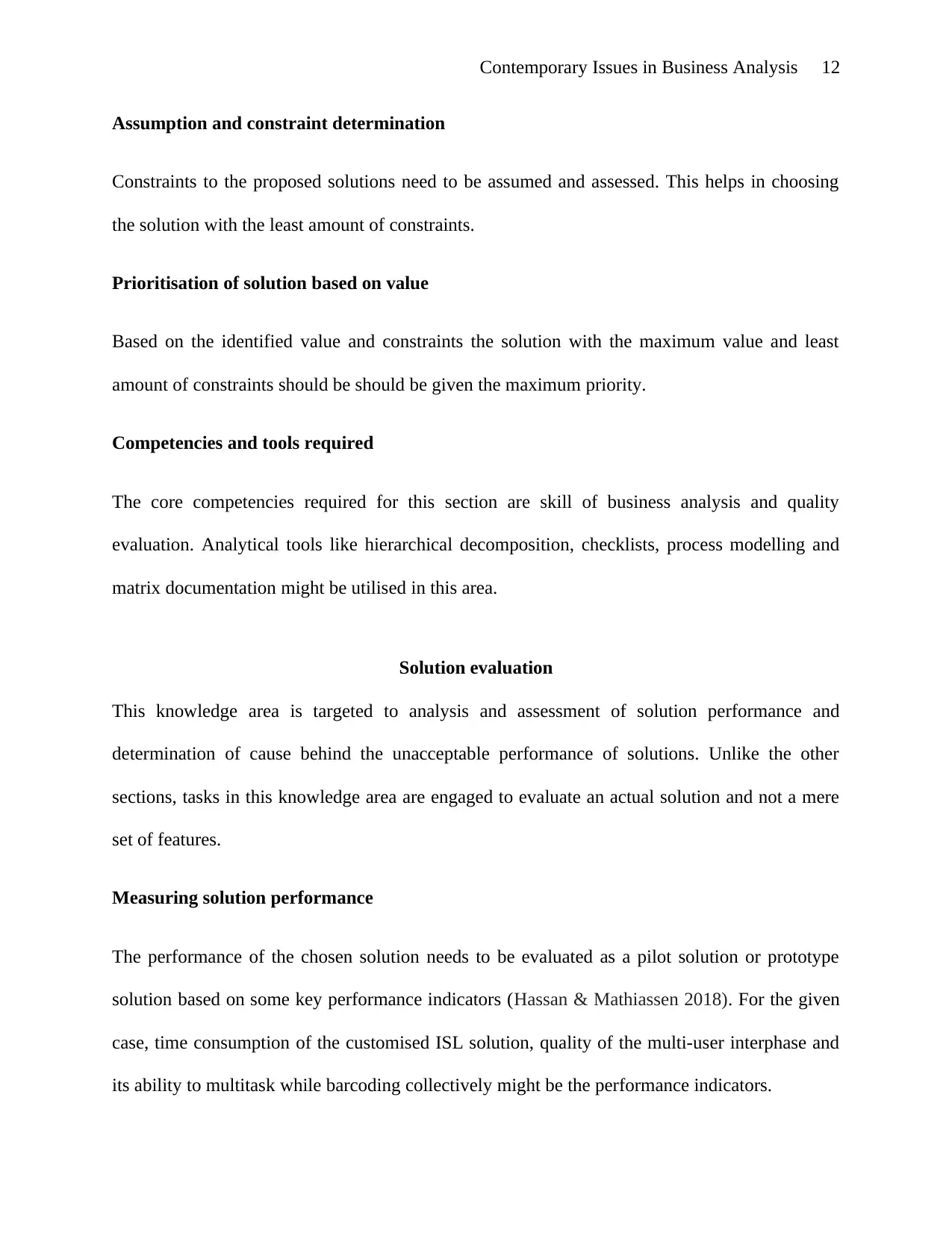
Contemporary Issues in Business Analysis 12
Assumption and constraint determination
Constraints to the proposed solutions need to be assumed and assessed. This helps in choosing
the solution with the least amount of constraints.
Prioritisation of solution based on value
Based on the identified value and constraints the solution with the maximum value and least
amount of constraints should be should be given the maximum priority.
Competencies and tools required
The core competencies required for this section are skill of business analysis and quality
evaluation. Analytical tools like hierarchical decomposition, checklists, process modelling and
matrix documentation might be utilised in this area.
Solution evaluation
This knowledge area is targeted to analysis and assessment of solution performance and
determination of cause behind the unacceptable performance of solutions. Unlike the other
sections, tasks in this knowledge area are engaged to evaluate an actual solution and not a mere
set of features.
Measuring solution performance
The performance of the chosen solution needs to be evaluated as a pilot solution or prototype
solution based on some key performance indicators (Hassan & Mathiassen 2018). For the given
case, time consumption of the customised ISL solution, quality of the multi-user interphase and
its ability to multitask while barcoding collectively might be the performance indicators.
Assumption and constraint determination
Constraints to the proposed solutions need to be assumed and assessed. This helps in choosing
the solution with the least amount of constraints.
Prioritisation of solution based on value
Based on the identified value and constraints the solution with the maximum value and least
amount of constraints should be should be given the maximum priority.
Competencies and tools required
The core competencies required for this section are skill of business analysis and quality
evaluation. Analytical tools like hierarchical decomposition, checklists, process modelling and
matrix documentation might be utilised in this area.
Solution evaluation
This knowledge area is targeted to analysis and assessment of solution performance and
determination of cause behind the unacceptable performance of solutions. Unlike the other
sections, tasks in this knowledge area are engaged to evaluate an actual solution and not a mere
set of features.
Measuring solution performance
The performance of the chosen solution needs to be evaluated as a pilot solution or prototype
solution based on some key performance indicators (Hassan & Mathiassen 2018). For the given
case, time consumption of the customised ISL solution, quality of the multi-user interphase and
its ability to multitask while barcoding collectively might be the performance indicators.
⊘ This is a preview!⊘
Do you want full access?
Subscribe today to unlock all pages.

Trusted by 1+ million students worldwide
1 out of 17
Related Documents
Your All-in-One AI-Powered Toolkit for Academic Success.
+13062052269
info@desklib.com
Available 24*7 on WhatsApp / Email
![[object Object]](/_next/static/media/star-bottom.7253800d.svg)
Unlock your academic potential
Copyright © 2020–2025 A2Z Services. All Rights Reserved. Developed and managed by ZUCOL.





